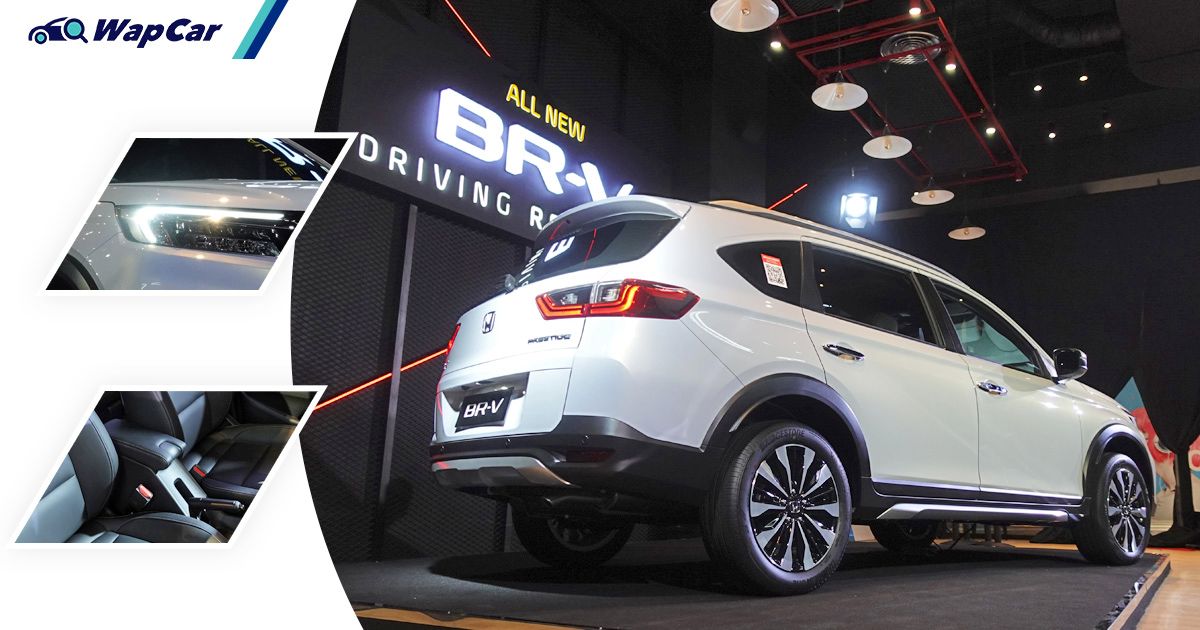![23 photos on why the all-new 2022 Honda BR-V is better than the ageing Avanza 01]()
The all-new 2022 Honda BR-V made its global debut in Indonesia yesterday, bringing with it an evolved exterior design, a revamped interior, as well as improvements to the safety department.
![23 photos on why the all-new 2022 Honda BR-V is better than the ageing Avanza 02]()
Honda has also managed to introduce the all-new BR-V ahead of the next-gen Toyota Avanza, the latter scheduled to make its debut later this year.
Also Read: This is the all-new 2022 Honda BR-V, full Honda Sensing, 6 airbags, new DOHC engine
Now, let's dive into Honda's upcoming people-mover.
Exterior – Evolved looks is certainly eye-catching
![23 photos on why the all-new 2022 Honda BR-V is better than the ageing Avanza 01]()
Standard across all variants of the all-new Honda BR-V are these reflector LED headlights with LED daytime running lights. These headlights flank a more angular Honda grille, giving the all-new BR-V a very imposing look.
![23 photos on why the all-new 2022 Honda BR-V is better than the ageing Avanza 02]()
The rear is adorned by a pair of LED tail lights, now with Honda’s signature lighting pattern. As before, the number plate recess is located at the bottom of the tailgate.
![23 photos on why the all-new 2022 Honda BR-V is better than the ageing Avanza 03]()
Further adding to the all-new BR-V’s ruggedness are its black body cladding and silver trim. Completing the looks are these dual-tone alloy wheels.
Interior – BR-V goes upmarket
![23 photos on why the all-new 2022 Honda BR-V is better than the ageing Avanza 04]()
While there was little to fault the outgoing BR-V’s interior, the all-new model has certainly turned things up a fair bit.
![23 photos on why the all-new 2022 Honda BR-V is better than the ageing Avanza 05]()
![23 photos on why the all-new 2022 Honda BR-V is better than the ageing Avanza 06]()
The dashboard now gains a soft touch segment on the passenger side, as well as additional USB ports.
![23 photos on why the all-new 2022 Honda BR-V is better than the ageing Avanza 07]()
![23 photos on why the all-new 2022 Honda BR-V is better than the ageing Avanza 08]()
But there’s more: upper variants of the all-new BR-V will add a full colour multi-info display nestled between the analogue dials, as well as cruise control buttons on the steering wheel.
![23 photos on why the all-new 2022 Honda BR-V is better than the ageing Avanza 09]()
And yes, Honda has addressed one of the biggest shortcomings of the outgoing BR-V by adding a centre arm rest that doubles as a storage compartment.
![23 photos on why the all-new 2022 Honda BR-V is better than the ageing Avanza 10]()
Honda has also given the all-new BR-V a number of USB charging ports, including for passengers in the second- and third-row seats.
![23 photos on why the all-new 2022 Honda BR-V is better than the ageing Avanza 11]()
![23 photos on why the all-new 2022 Honda BR-V is better than the ageing Avanza 12]()
Powertrain – Honda’s mainstream models start to embrace DOHC
![23 photos on why the all-new 2022 Honda BR-V is better than the ageing Avanza 13]()
The all-new Honda BR-V is the next model to receive Honda’s new DOHC engine, replacing the long-serving SOHC unit.
![23 photos on why the all-new 2022 Honda BR-V is better than the ageing Avanza 14]()
The new naturally-aspirated 1.5-litre DOHC petrol engine that’s borrowed from the current-generation Honda City does 121 PS and 145 Nm. It can be mated either to a CVT or manual transmission.
Also Read: Things you probably missed in the Honda N7X reveal
Safety – Massive improvements
![23 photos on why the all-new 2022 Honda BR-V is better than the ageing Avanza 15]()
At long last, the Honda BR-V is available with six airbags, a massive step-up from the predecessor model’s paltry two airbags.
![23 photos on why the all-new 2022 Honda BR-V is better than the ageing Avanza 16]()
But that’s not all as Honda has fitted the improved Honda Sensing ADAS suite into the all-new BR-V, encompassing features like Adaptive Cruise Control (ACC), Road Departure Mitigation (RDM), Lane Keep Assist System (LKAS), Collision Mitigation Brake System (CMBS), Auto High Beam (AHB) and Lead Car Departure Notification (LCDN) - the latter not available on the Honda City or Honda CR-V.
![23 photos on why the all-new 2022 Honda BR-V is better than the ageing Avanza 17]()
The final touch is the inclusion of the Honda LaneWatch camera.
Also Read: All-new 2022 Honda BR-V patent images leaked, gets Honda Sensing
Conclusion – Definitely a model worth waiting for
![23 photos on why the all-new 2022 Honda BR-V is better than the ageing Avanza 18]()
From the looks of it, Honda has done a swell job with the second-generation Honda BR-V.
![23 photos on why the all-new 2022 Honda BR-V is better than the ageing Avanza 19]()
Not only does it look the part, the bump in safety equipment certainly is an added bonus for families which want an SUV with all the bells and whistles.
![23 photos on why the all-new 2022 Honda BR-V is better than the ageing Avanza 20]()
The second-generation Honda BR-V is expected to be launched in Malaysia in late-2022 or early-2023, after factoring in 12 to 18 months in lead-time required for local assembly (CKD) and local parts sourcing.
![23 photos on why the all-new 2022 Honda BR-V is better than the ageing Avanza 21]()
However, intermittent Covid-19-related travel restrictions could delay things further. Already, Honda Malaysia has had to push back several car launches, including the Honda City Hatchback and all-new Honda Civic.
Also Read: Next-gen Honda BR-V: What improvements does it need to be the king of 7-seater SUVs again?






























